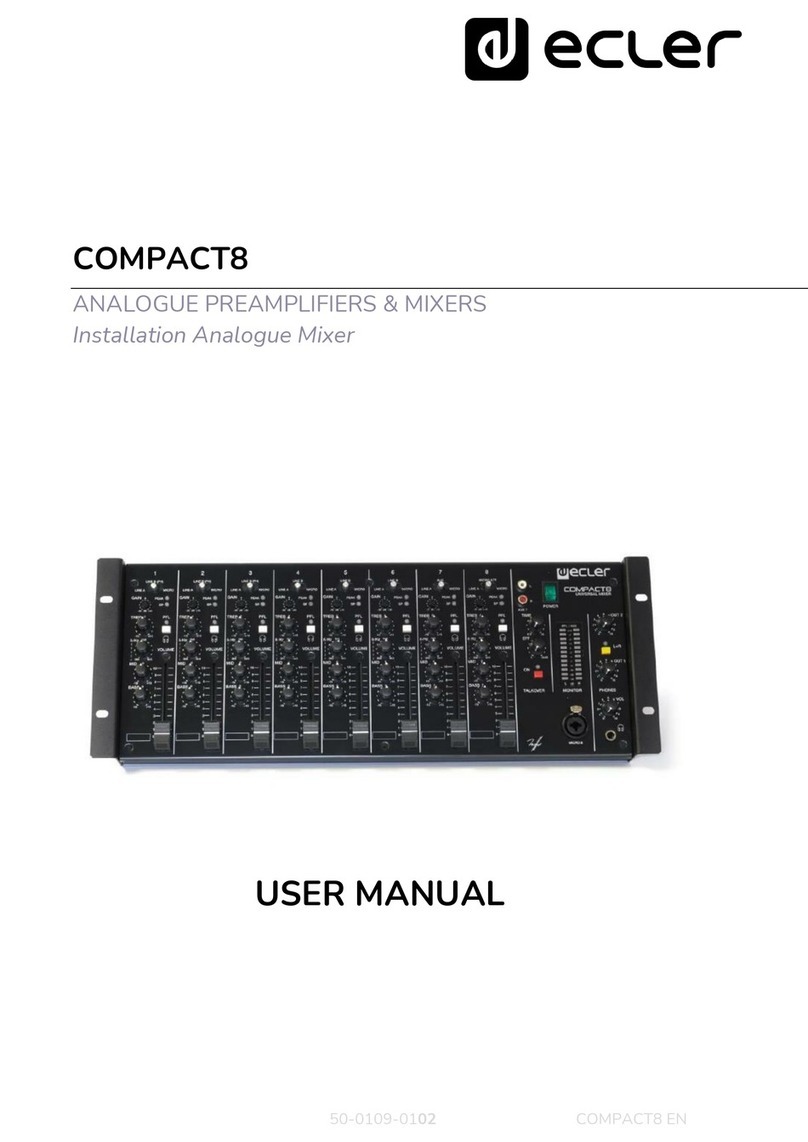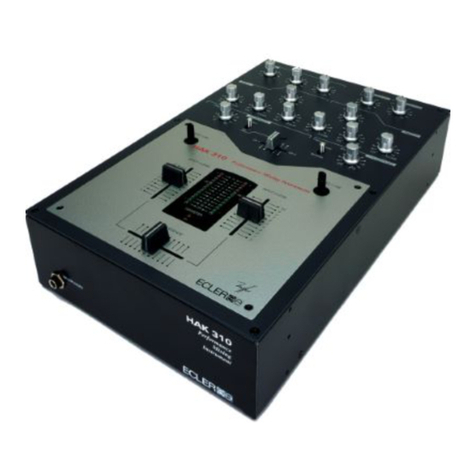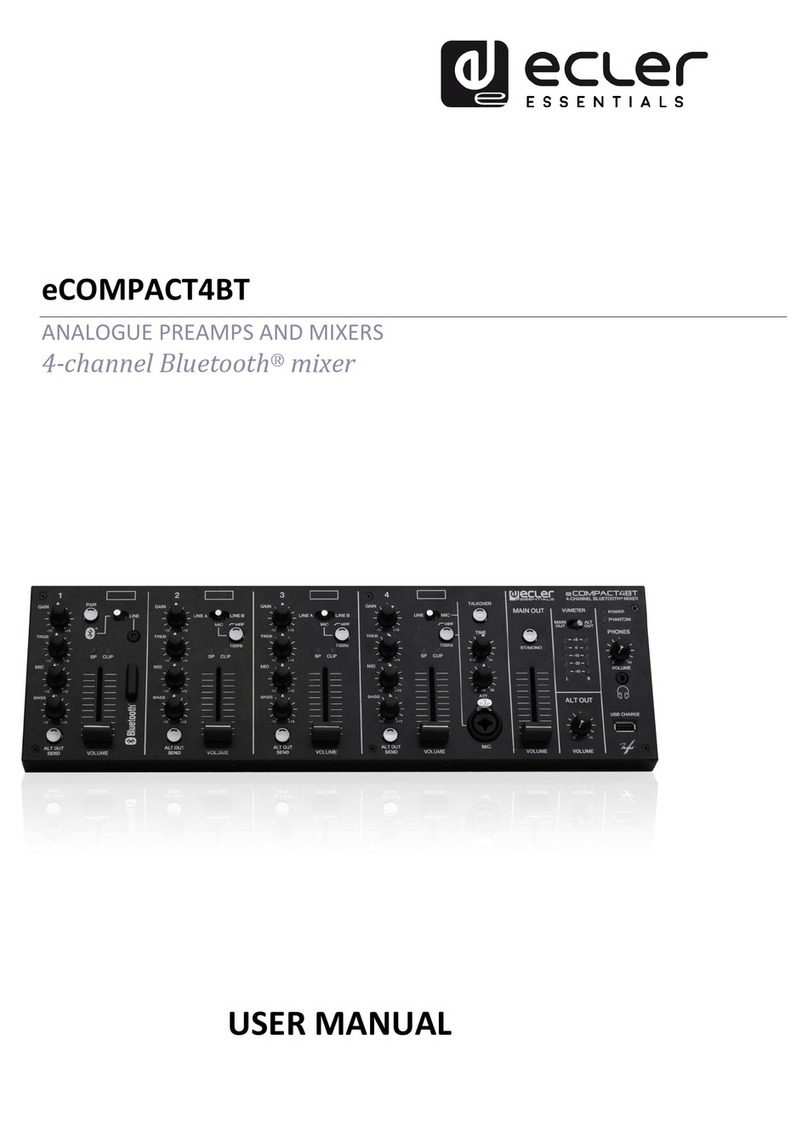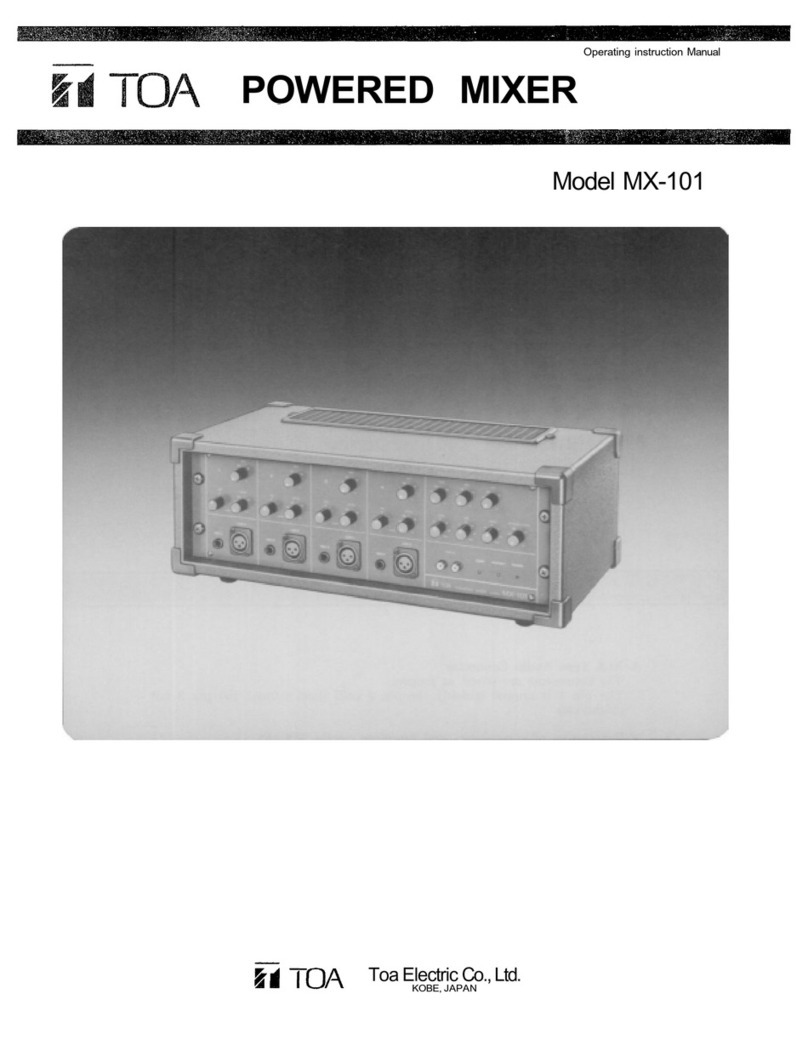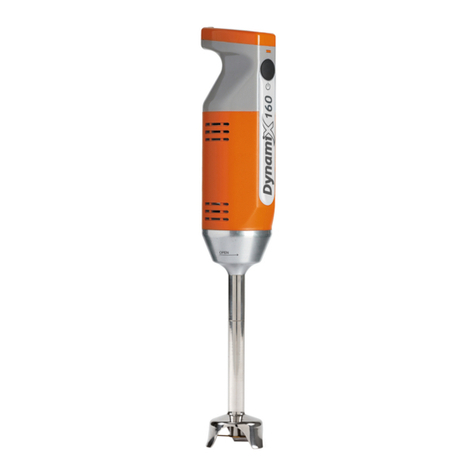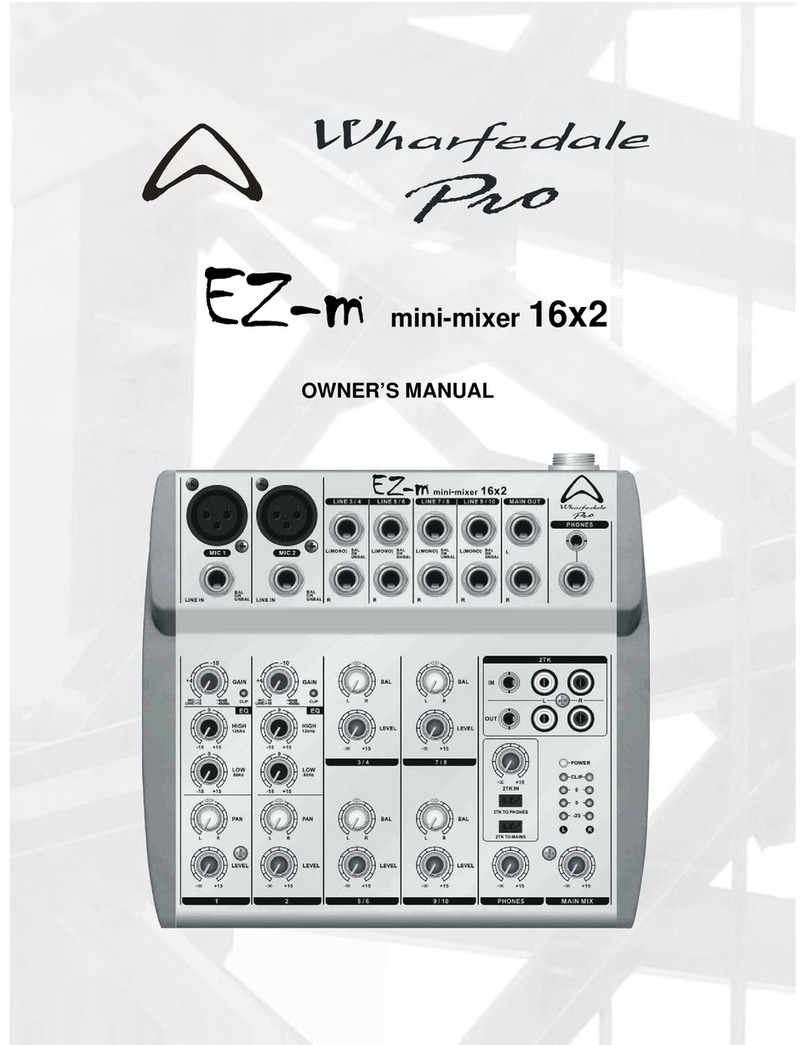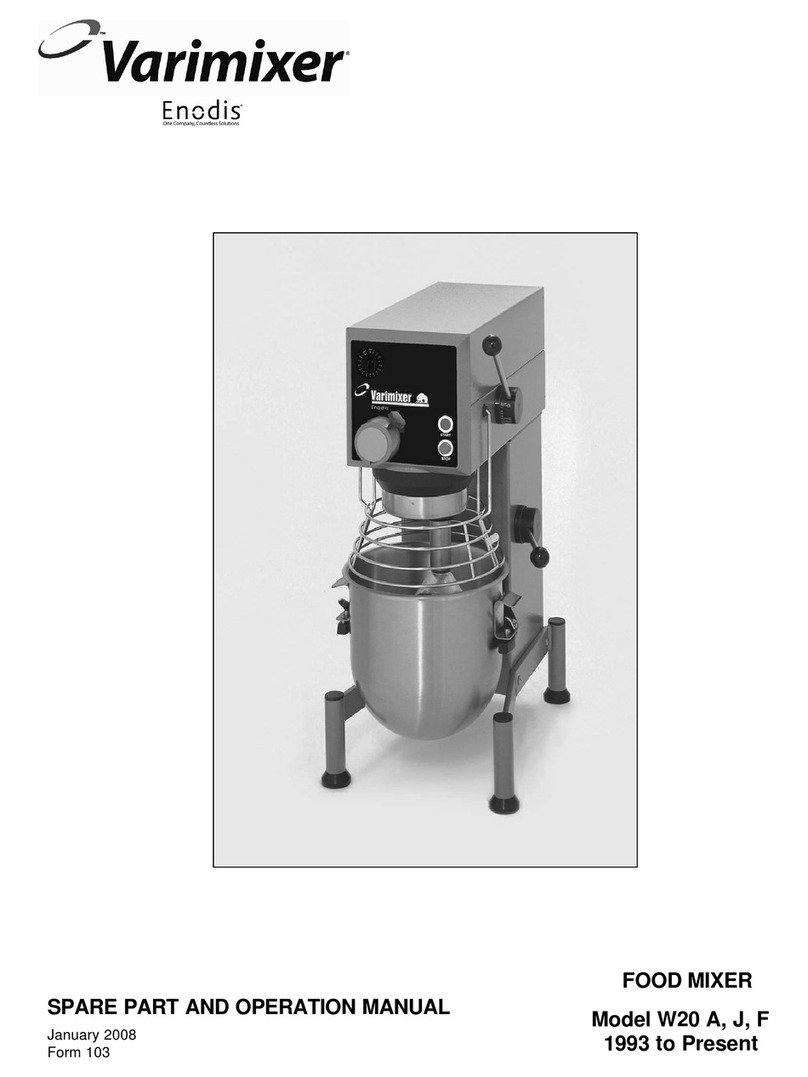Ecler MAC90v User manual

USER MANUAL
MANUAL DE INSTRUCCIONES
NOTICE D’EMPLOI
BEDIENUNGSANLEITUNG
MAC90v

2

3
INSTRUCTIONS MANUAL MAC90v
1. IMPORTANT REMARK 04
1.1. Safety Precautions 04
2. INTRODUCTION 04
3. INSTALLATION 05
3.1. Placement and mounting 05
3.2. Connectable Signal Sources 05
4. OPERATION AND USE 06
4.1. Start up 06
4.2. Monitoring 06
4.3. Channel gain and equalization 07
4.4. Using the CROSSFADER 07
4.5. Auxiliary send 08
4.6. AUX input 08
4.7. Inserts 08
4.8. Talkover 08
4.9. Outputs 08
5. CONSIDERATIONS 09
5.1. Ground loops, background noise 09
5.2. Cleaning 09
6. TECHNICAL CHARACTERISTICS 36
7. DIAGRAMS 37
7.1. Configuration diagram 37
7.2. Function list 38
7.3. Function diagram 40
7.4. Block diagram 41
All numbers subject to variation due to production tolerances. ECLER S.A. reserves the right to make
changes or improvements in manufacturing or design which may affect specifications.

4
1. IMPORTANT REMARK
We thank you for trusting on us and choosing our MAC90v mixer. In order to get the
most in operation and efficiency from your mixing unit, it is VERY IMPORTANT for you -before
you plug anything -to read this manual very carefully and take seriously into account all
considerations specified within it.
In order to guarantee the optimum operation of this unit, we strongly recommend that
its maintenance be carried out by our Authorised Technical Services.
1.1. Safety Precautions
This apparatus must be earthed through its mains cable.
Do not expose the unit to rain or water splashes, and do not place liquid containers or
incandescent objects like candles on top of the unit. Do not obstruct the ventilation
shafts with any kind of material.
Any change in the configuration of the unit must be carried out by a qualified technician.
Should any connection / disconnection task be done, always disconnect the unit from the
mains supply.
There are no user serviceable parts inside the unit.
2. INTRODUCTION
The MAC90v mixer is designed for its use in discotheques, ballrooms, bars, disco bars
and external P.A. applications.
The MAC90v has 8+1 mixable channels, i.e. 8 channels with conventional sliding fader
plus one special channel for the effect return with rotary potentiometer, which can be used to
input normal line-level signals from any source. It features 12 stereo inputs: 3 PHONO, 4 HIGH
LINE (high line level for compact disc, DAT, MP3 players), and 5 LOW LINE, AUX RTN and MIX;
plus 4 more inputs for balanced microphones (XLR 3). The AUX RTN input connector is duplicated
on the front panel (13), so an additional sound source (portable CDs, portable DAT, or even
walkmans) can be instantly connected to the mixer without having to change fixed configurations.
All channels have a lever switch input selector, independent gain control and 3-band
tone controls. The MAC90v also has a removable, externally exchangeable CROSSFADER to
which any channel can be assigned via a set of switches with LED indicator to show which
channels are currently routed to what side of the crossfader.
All inputs are PFL-capable in order to visually (through the VU meters) and
acoustically (through headphones) monitor any signal connected to the inputs of the unit.
In the MAC90v, we have cared specially about the roughness, long-time response and
maximum adaptability to the DJ needs, getting a total ease of operation.

5
3. INSTALLATION
3.1. Placement and mounting
The first thing to take into account when looking for the placement of the MAC90v is
your comfort and an easy access to all the connections.
The MAC90v has 19" (482.6 mm), 8U (355 mm) rack mounting ears that allow you
to place it in a standard rack.
Because of the high gain of the PHONO and MIC inputs, the mixer must be placed as
far as possible from noise sources (dimmers, engines, etc.) as well as from any mains cable.
You should never, under any circumstance, remove the metallic cover of the mixer.
The MAC90v, being a low consumption unit, does not need any cooling; you should
anyway avoid exposure to extreme temperatures and the operating environment must be as dry
and dust free as possible.
The MAC90v operates under voltages between 90 and 264 V at 47 to 63 Hz. All
models of the MAC v-series feature an over dimensioned power supply that adapts to the
mains voltage in any country of the world with no need to make any adjustments.
In order to protect the mixer from eventual mains overloads, it has a time-lag 0,5 A
(60) mains protection fuse. Should this fuse ever blow off, disconnect the mixer from mains
and replace it with an identical one. NEVER REPLACE THE FUSE WITH ANOTHER ONE WITH A
HIGHER VALUE.
ATTENTION: Changing the fuse must be performed by qualified technical personnel.
3.2. Connectable Signal Sources
-Turntables / Phono: They must be fitted with a magnetic cartridge with nominal
output level between -60dBV and -20dBV (1 to 100 mV). The PHONO (46) inputs of the
MAC90v have a high headroom (margin before saturation) and it can handle higher output
cartridges than what is usual. These inputs are supplied with a nominal input sensitivity of
-40dBV (10mV).
-Microphones: The MIC inputs (43) are ready for a nominal input level of -50dBV
(3.16 mV) and are equipped with XLR 3 connectors. These inputs provide, through the input
selector (1) at ATT position, an input sensitivity reduction of 20dB; this is, from -50 to
-30dBV (3.16 to 31.6mV). The connection of balanced signals is as follows:
Hot or direct signal >Pin 2
Cold or inverted signal >Pin 3
Ground >Pin 1
Low impedance (200 to 600Ω) monophonic microphones must be used. In case of
working with an unbalanced connection Pin 1 and Pin 3 must be short-circuited.
The MAC90v features a Phantom power supply for the connection of condenser
microphones. A switch for general activation of the phantom power can be found on the front
panel of the unit (15). However, a set of internal jumpers allow you to inhibit the phantom
power for individual microphone inputs. The default setting of these jumpers on the MAC90v is
"Phantom ON". See configuration diagram.

6
-LINE Inputs. Given the important level differences between usual LINE and CD
sources (e.g. Tape decks), the MAC90v provides specialized inputs for each source. The
sensitivity of the HIGH LINE input (45) is 0dBV (1V), while the LOW LINE (44) sensitivity is
-10dBV (316mV).
Compact disc, DAT, MP3, DVD Audio... should be connected to the HIGH LINE input.
Tape recorders, cassettes, tuners, videos... should be connected to the LOW LINE input.
-Headphones: In order to achieve the best performance, they should be high
impedance type (200-600Ω). They must be connected to the HEADPHONES OUT (34)
connector, a standard ¼" stereo jack. Connect ground to sleeve, ring to right and tip to left.
-Other mixers: The MIX (49) input provides a direct access to the main mix bus, so
this is a perfect input for another mixer to be plugged in without using up a regular input.
-Power amplifiers: See paragraph 4.9.
4. OPERATION AND USE
4.1. Start up
Power up the mixer by pushing the POWER (16) switch. The green pilot-light,
integrated into the switch itself, will immediately light up. Although the noise generated by
powering up the MAC90v is reduced to a bare minimum and is nearly null with the MASTER
(26, 33) faders down, it is always advisable not to forget about this power-up sequence: sound
sources, mixer, equalizers, active filters and power amplifiers. Power down the equipment by
following the inverse sequence. This way the peaks or transients produced by powering
up /down a device do not affect the following one in the audio chain and, as a result, they do
not reach the loudspeakers, which are the most vulnerable audio elements in this case.
4.2. Monitoring
The MAC90v is equipped with an acoustical and visual monitoring system, through
headphones, CUE output and VU METER. When switching ON any of the PFL buttons, signal(s)
present at the input(s) will be seen at the VU METER. If no switch is at the ON position, the
signal present at the main mix bus is heard (open faders). By pushing the OUT1/OUT2/AUX
buttons, the right VU-Meter displays the signal present at the output 1 or output 2. If no switch
is at the ON position, the signal present at the main mix bus is shown (open faders).
It is also possible to monitor through the CUE (55) output. This output carries the very
same signal as the headphones output does. Its nominal output level is 0dBV (1V) and it is
controlled by the rotary knob CUE VOL (36).

7
4.3. Channel gain and equalization
These controls allow individual input sensitivity and tone adjustments for each
channel.
Thanks to the GAIN (2) control, you can precisely adjust the signal level of an
incoming musical signal to match the level of the music that is playing on air through another
channel. This operation may be performed visually (through the left VU-meter) and acoustically
(through the headphones), successively comparing both signals with the PFL buttons. The Gain
knobs offer an adjustment range of ±20dB.
The tone controls (3, 4, 5) of channels 1, 2, 3, 4, 5 and AUX have a range of -20 to
+10dB, while channels 6, 7 and 8 range from CUT to +10dB.
4.4. Using the CROSSFADER
The MAC90v provides a short travel sliding potentiometer placed horizontally. This
potentiometer is called CROSSFADER (38) and enables a direct mixing of the signals present at
any inputs (except auxiliary channel). This allows the DJ to prepare the mix and simply
crossfade back and forth between them.
Two pushbuttons on each channel let you assign that channel to either side of the
Crossfader. XFA (10) sends the signal to side A and XFB (11) to side B of the crossfader. Two
corresponding LED indicators help to identify which cannel is assigned to what side of the
Crossfader.
If none of these two switches is activated, the signal bypasses the crossfader circuit
and passes directly to the main mix bus and the corresponding MIX LED lights up. These
switches also serve when assigning the talkback activation channel(s) (see paragraph 4.8).
If, instead of using the crossfader, you would like to have two auxiliary mixing
channels at the XFA and XFB outputs, the cossfader potentiometer can be substituted with a
blind module Ref. BC01. This way, two more submixes can be made, apart from the main mix,
or two more auxiliary outputs can be available.
The MAC90v's CROSSFADER is based around an electronic VCA circuit that greatly
extends its life and additionally has the great advantage of being removable and replaceable by
yourself. To do so, just follow these instructions:
1-Remove the screws of the plate that hold the CROSSFADER.
2-Remove the set from the mixer.
3-Detach the multipin connector.
4-Replace the whole set or remove the screws that tie the potentiometer.
5-Tie the new potentiometer and the associated printed circuit and multipin
connector to the plate.
6-Attach the multipin connector.
7-Place the set on the mixer.
8-Fix the screws of the plate.

8
4.5. Auxiliary send
The MAC90v is equipped with a stereo bus of auxiliary sends, AUX (6). This send is
factory preadjusted to postfader, this is, any change on the channel fader (12) affects the level
present at the output of the auxiliary bus AUX OUT (53). This setting can be internally modified
and converted to prefader by simply changing a jumper, as seen in the configuration diagram.
4.6. AUX input
An AUX IN (13, 48) allows the return of the signal once it has been processed by an
external effect. This input can also be used as a regular HIGH LINE level input. The bus to
which it is assigned can be configured with internal jumpers (see configuration diagram). It is
factory preadjusted to PGM bus.
4.7. Inserts
Plugging a 6,35 mm stereo jack to the INS connector (there is a connector for each of
the L left and R right channels (41, 42), the microphone signal can be redirected to a particular
effect for that input only. Sleeve is ground, tip is send and ring is return. If you use a mono
jack, instead of a stereo one, with the ring short circuited to ground there are two new
applications:
-If you plug the jack fully in, this works as an output, having a post-preamplifier signal and
cutting its way to the main mix bus.
-Plugging the jack "halfway in", only to the "first click", you get a direct post-preamplifier
signal, but the sound ALSO goes its way to the main mix bus.
4.8. Talkover
Assignment: The channels that have both XFA and XFB simultaneously depressed
(MIC indicator lit) automatically reduce the signal level of the channels that have the crossfader
buttons in any other position and of course have open faders. This happens at the first voice
"hit" of the DJ or speaker on the microphone plugged to the channel with both XF buttons
pressed. When the DJ stops talking the music level comes up to the initial level.
Usage: The talkover is enabled through the ON (32) switch, and has efficiency, EFF
(37), main signal level attenuation (between 0 and 30 dB) and recovery time, TIME (39), the
time necessary for a progressive come back to the original level (between 0,1 and 3 sec).
4.9. Outputs
The MAC90v mixer has two independent outputs, OUT1 and OUT2. Each one has its
own volume control, with a sliding fader for OUT1 (33), and a rotary one for the OUT2 (26).
Both outputs have a dedicated balance control BAL (29, 23).
You must be careful when setting up the general output level of the mixer. The "clip"
display of the connected power amplifiers must never remain permanently lit, but do it only
occasionally by following the rhythm of the bass signals that are being played.
The MAC90v mixing unit is factory adjusted at 0dBV/1V, although this output can be
internally modified to +6dBV/2V. See configuration diagram.

9
The OUT1 output (56, 57) is balanced or symmetrical, and the pin-out of the
connector is as follows:
Hot or direct signal >Pin 2
Cold or inverted signal >Pin 3
Ground >Pin 1
The balanced circuit simulates an output transformer, so if you wish to use OUT1 in
non-balanced mode, you should short circuit the unused pin to ground. Otherwise, the signal
will not have an appropriate level and quality.
The OUT2 output (58) is non-balanced or asymmetrical.
The MAC90v has two recording outputs: REC1 (52), which is pre-talkover, i.e. no
signals which activate the talkover (both XF buttons pressed and MIC indicator lit) are passed
to this output, so no attenuation occurs, and REC2 (54), which is influenced by the talkover.
Finally, a MONO (30) switch that converts an stereo signal into a monophonic one or
sends one side to both channels. This switch affects the outputs OUT1, OUT2, and REC2.
AUX OUT (53) provides an output for the auxiliary bus (see paragraph 4.5).
The CUE output (55) allows for easy monitoring along with an external amplification
system and carries the very same signal as the HEADPHONES output.
5. CONSIDERATIONS
5.1. Ground loops, background noise
You should always make sure that the signal sources coming to the unit, as well as all
devices connected to its outputs, do not have their grounds interconnected, that is; ground must
never come from two different devices. Should this ever happen, noises could occur and seriously
interfere the sound quality.
Cable shielding, when connected to the chassis, must never be interconnected, so as to
avoid ground loops.
The MAC90v mixer has been designed for the lowest possible background noise.
Independently from the electronic design itself, background noise level will directly depend on the
right installation and use of the mixing unit.
I. e.: setting a channel VOL to "2" and the output to "10" is not the same as the other
way round. In the first case, the signal coming to the mixing amplifier -which has got its own
noise -is low, and so is the signal-to-noise ratio (low signal). When the output amplifier boosts the
whole signal we will get a very high background noise. In the second case -with the channel
fader at maximum -the mixing level is high, and so is the signal-to-noise ratio. When the signal
reaches the VOL OUTPUT and is boosted, it will keep a much better signal-to-noise ratio than in
the preceding case.
5.2. Cleaning
The front panel should not be cleaned with dissolvent or abrasive substances because
silk-printing could be damaged. To clean it, use a soft cloth slightly wet with water and neutral
liquid soap; dry it with a clean cloth. Be careful that water never gets into the amplifier through
the holes of the front panel.

10
MANUAL DE INSTRUCCIONES MAC90v
1. NOTA IMPORTANTE 11
1.1. Precauciones 11
2. INTRODUCCIÓN 12
3. INSTALACIÓN 12
3.1. Ubicación y montaje 12
3.2. Fuentes de señal conectables 12
4. OPERACIÓN Y USO 13
4.1. Puesta en funcionamiento 13
4.2. Monitoraje 14
4.3. Ganancia y ecualización de vía 14
4.4. Utilización del CROSSFADER 14
4.5. Envío auxiliar 15
4.6. Entrada AUX 15
4.7. Inserciones 15
4.8. Talkover 15
4.9. Salidas 16
5. CONSIDERACIONES 17
5.1. Bucles de masa, ruido de fondo 17
5.2. Limpieza 17
6. CARACTERÍSTICAS TÉCNICAS 36
7. DIAGRAMAS 37
7.1. Diagrama de configuración 37
7.2. Lista de funciones 38
7.3. Diagrama de funciones 40
7.4. Diagrama de bloques 41
Todos los datos están sujetos a variación debida a tolerancias de producción. ECLER S.A. se reserva el derecho
de realizar cambios o mejoras en la fabricación o diseño que pudieran afectar las especificaciones.

11
1. NOTA IMPORTANTE
Agradecemos su confianza por haber elegido nuestro mezclador MAC90v. Para
conseguir la máxima operatividad y rendimiento de su mesa de mezclas es MUY IMPORTANTE
antes de su conexión leer detenidamente y tener muy presentes las consideraciones que en este
manual se especifican.
Para garantizar el óptimo funcionamiento de este aparato recomendamos que su
mantenimiento sea llevado a cabo por nuestros Servicios Técnicos autorizados.
1.1. Precauciones
Este aparato debe ser conectado a tierra mediante su cable de alimentación.
No exponga el aparato a la caída de agua o salpicaduras, no ponga encima objetos con
líquido ni fuentes de llama desnuda, como velas. No obstruya los orificios de ventilación
con ningún tipo de material.
Cualquier cambio en la configuración debe ser realizado por personal técnico cualificado.
En caso de requerir alguna intervención y/o conexión desconexión del aparato debe desconectarse
previamente de la alimentación.
En el interior del aparato no existen elementos manipulables por el usuario.
2. INTRODUCCIÓN
El mezclador MAC90v está concebido para el uso en discotecas, salas de fiesta, pubs,
disco bares y aplicaciones de sonorización.
El MAC90v dispone de 8+1 vías mezclables, 8 canales con fader deslizante
convencional y una vía especial para retorno de efectos con fader rotativo a la que también puede
conectársele cualquier señal que entregue nivel de línea. Dispone de 12 entradas estereofónicas: 3
de PHONO, 4 HIGH LINE (Línea de alto nivel para compact disc, DAT, reproductores de MP3), 5
de LOW LINE, AUX RTN y MIX; más 4 entradas preparadas para micrófonos balanceados (XLR 3).
La entrada AUX RTN se encuentra además duplicada en el panel frontal AUX (13) para que
pueda ser utilizada como entrada de emergencia (CD portátiles, DATs portátiles o incluso
walkmans) sin necesidad de tocar el conexionado.
Todos los canales disponen de un selector de entradas de palanca, control de ganancia
independiente para cada una de las vías así como controles de tono de tres bandas. El MAC90v
incorpora un potenciómetro CROSSFADER reemplazable exteriormente y asignable a cualquiera de
las entradas mediante conmutadores con indicador luminoso para facilitar la identificación de
las vías asignadas a crossfader y su posición.
Todas las entradas disponen de la función PFL para monitorizar visualmente mediante el
VU-Meter y acústicamente mediante auriculares cualquier señal conectada a las entradas de la
mesa.
En el MAC90v se ha cuidado por encima de todo la fiabilidad, dureza al paso del tiempo
y la máxima adaptabilidad a las necesidades del Disc-jockey, consiguiendo de esta forma una total
comodidad de operación.

12
3. INSTALACIÓN
3.1. Ubicación y montaje
La principal consideración a tener en cuenta en el momento de buscar la ubicación del
mezclador MAC90v debe ser la máxima comodidad de trabajo del operador, permitir una total
facilidad en la realización de las conexiones que el mezclador va a ser punto de partida y llegada.
El MAC90v dado su tamaño standard de 19" (482.6mm) y 8 unidades rack de altura
(355mm), permite ser enrracado.
Dada la elevada ganancia de las entradas de PHONO y de MICRO debe procurarse situar
el mezclador lo más alejado posible de fuentes de ruido (variadores de tensión, motores, etc. ...)
así como de cualquier cable de red. Por esta misma razón y bajo ninguna circunstancia debe
quitarse la tapa metálica del aparato.
Ya que el consumo del MAC90v es muy bajo, éste no precisa ventilación, sin embargo
debe evitarse que esté expuesto a una temperatura extrema y que la atmósfera del local en que
esté emplazado sea lo más seca y limpia de polvo posible.
El MAC90v funciona con corriente alterna de 90 a 264V y 47 a 63 Hz. Todos los
modelos MAC serie vequipan una fuente de alimentación sobredimensionada capaz de
adaptarse sin ningún tipo de ajuste a la tensión de red de cualquier país del mundo.
Para proteger a la mesa de mezclas de eventuales sobrecargas, el MAC90v está
protegido con un fusible de red (60) de 0.5A temporizado. En el caso de que éste se fundiera se
sustituiría por otro de idénticas características. EN NINGÚN CASO DEBE PONERSE UN FUSIBLE
DE VALOR MÁS ELEVADO.
PRECAUCIÓN: El cambio de fusibles debe ser realizado por personal técnico
cualificado.
3.2. Fuentes de señal conectables
-Platos giradiscos: Deben ir equipados con cápsula magnética capaz de dar un nivel de
salida nominal entre -60 y -20dBV (1 y 100mV). Dado que las entradas de PHONO (46) del
MAC90v tienen una elevada capacidad de sobrecarga, puede admitir cápsulas de mayor nivel de
salida. Estas entradas tienen una sensibilidad nominal de -40dBV(10mV).
-Micrófonos: Las entradas de MICRO (43),están preparadas para un nivel nominal de
entrada de -50dBV (3.16mV). Son del tipo XLR 3. Permiten a través del selector de entradas (1)
en posición ATT una reducción de 20dB de la sensibilidad de esta entrada, pasaría pues de -50 a
-30dBV (3.16 a 31.6mV).
Estas entradas de micrófono admiten la conexión en modo balanceado para ello se
realizará la conexión del conector XLR como se indica.
Vivo o señal directa >Terminal 2
Frío o señal invertida >Terminal 3
Masa >Terminal 1
Los micrófonos deben ser de baja impedancia (de 200 a 600Ω) y monofónicos. Para
conexiones NO balanceadas cortocircuitar a masa el terminal 3.

13
El MAC90v dispone de alimentación phantom para micrófonos equipados de
condensador. El conmutador de activación general de la alimentación phantom se encuentra
ubicado en el panel frontal del aparato (15). Un jumper interno permite además inhibir el
funcionamiento de la alimentación phantom de forma individual para cada micro. Las entradas
MIC del MAC90v se sirven de fábrica con el jumper interno en posición “phantom ON”. Ver
diagrama de configuración.
-Entradas LINE. Dadas las importantes diferencias de nivel existentes entre las fuentes
del tipo CD y de LINE convencional (por ejemplo magnetófonos a cassette), el MAC90v incorpora
entradas diferenciadas para cada uno de estos elementos. Así la sensibilidad de las entradas
marcadas como HIGH LINE (45) es 0dBV (1V) y las de LOW LINE (44) es -10dBV (316mV).
Reproductores CD, DAT, MP3, DVD Audio... se conectarán a las entradas HIGH LINE.
Magnetófonos, cassettes, sintonizadores, videos... se conectarán a las entradas LOW LINE.
-Auriculares: Para obtener el mejor rendimiento en su funcionamiento, éstos deberán ser
de alta impedancia (200-600Ω). Se conectarán a la salida HEADPHONES OUT (34) situada en su
propia placa de mandos mediante un conector jacknormalizado de 1/4" estereofónico. El casquillo
del jack será la masa, el anillo central el canal derecho y la punta el canal izquierdo.
-Otras mesas de mezcla: La entrada MIX (49) ofrece un acceso directo al bus de
mezcla principal por lo que es una entrada perfecta para interconectar con otra mesa de
mezclas sin necesidad de utilizar una entrada normal.
-Amplificadores de potencia: Ver apartado 4.9.
4. OPERACIÓN Y USO
4.1. Puesta en funcionamiento
Esta se realizará mediante el interruptor de red POWER (16) se iluminará el piloto verde
integrado en el propio interruptor. Aunque el ruido producido por la puesta en funcionamiento del
MAC90v es mínimo y queda prácticamente anulado al hacerlo con los controles de MASTER
(26-33) cerrados, siempre resulta muy recomendable poner en marcha todos los aparatos
siguiendo la secuencia siguiente: fuentes de sonido, unidad de mezclas, ecualizadores, filtros
activos y finalmente amplificadores de potencia. El paro de los aparatos debe realizarse en la
secuencia inversa. Siguiendo este orden los picos o transitorios producidos por el encendido o
apagado de los aparatos no afecta a los siguientes, y por consiguiente tampoco llegan a los
altavoces, elementos extremadamente susceptibles de averiarse en estos casos.

14
4.2. Monitoraje
El MAC90v está dotado con un sistema de monitorización auditiva y visual a través de
auriculares / salida CUE y doble VU METER. Accionando cualquiera de los interruptores PFL,
oiremos por los auriculares y veremos por el VU METER izquierdo la señal presente en la-s vía-s
de entrada. Cuando no hay ningún interruptor accionado se monitoriza la señal presente en el
bus de mezclas (faders abiertos). Accionando los interruptores OUT1/OUT2/AUX, se visualiza
en el VU METER derecho la señal presente en la salida 1, la salida 2 o la salida auxiliar. Cuando
no hay ningún interruptor accionado se visualiza la señal presente en el bus de mezclas (faders
abiertos).
También es posible realizar la monitorización a través de la salida CUE (55). En esta
salida se encuentra presente la misma señal que existe en la salida de auriculares, su nivel
nominal es de 0dBV (1V). Mediante el potenciómetro rotativo CUE VOL (36) se controla el nivel
existente en esta salida.
4.3. Ganancia y ecualización de vía
Estos controles permiten ajustar individualmente para cada una de las vías los niveles de
sensibilidad de entrada y tonos.
Mediante el control de GAIN (2), ajuste fino de la ganancia de entrada, equipararemos el
nivel de señal a mezclar con la que esté sonando ya en directo a través de otra vía. Esta operación
puede realizarse visualmente mediante el VU METER izquierdo y auditivamente mediante los
auriculares, realizando sucesivas comparaciones entre ambas señales a través de los interruptores
de PFL. Los controles GAIN proporcionan un margen de ajuste de ±20dB.
Los controles de tono (3-4-5) de las vías 1, 2, 3, 4, 5 y AUX proporcionan una
actuación de -20+10dB y en las vías 6, 7 y 8 de CUT a +10dB
4.4. Utilización del CROSSFADER
El MAC90v dispone de un potenciómetro deslizante de corto recorrido dispuesto en
posición horizontal. Dicho dispositivo, denominado CROSSFADER (38), realiza la transición directa
de las señales presentes en cualquiera de las vías excepto la auxiliar. Esto permite al Disc-jockey
prepararse las mezclas y cambiar de una a otra simplemente accionando el CROSSFADER.
Dos pulsadores por vía ubicados bajo el de PFL permiten la asignación a crossfader de
cualquiera de las entradas, canal A, XFA (10) o B, XFB (11) existe un indicador luminoso para
facilitar la identificación de las vías asignadas a crossfader y su posición A o B. En caso de no
asignar a ninguna posición de crossfader la señal pasa directamente al bus de mezcla principal
iluminándose el indicador correspondiente a MIX. Estos pulsadores sirven también como
asignación de vía-s que accionan el talkover (ver apartado 4.8.).
Si en lugar de utilizar el Crossfader nos interesa disponer de dos vías auxiliares de
mezcla en las salidas XFA y XFB sustituiremos el potenciómetro de Crossfader por el módulo
ciego Ref. BC01. De esta forma podremos realizar además de la mezcla principal dos submezclas
independientes, o disponer de dos salidas auxiliares postfader independientes.
El CROSSFADER del MAC90v equipa un circuito electrónico VCA que alarga
considerablemente su vida útil y tiene además la ventaja de permitir ser sustituido desde el
exterior. Vd. mismo podrá reemplazar fácilmente el CROSSFADER, para ello deberá seguir las
siguientes indicaciones:

15
1-Retire los tornillos exteriores de la placa que sujeta el CROSSFADER.
2-Extraiga el conjunto de su cavidad.
3-Desconecte el conector multiterminal.
4-Reemplace el conjunto potenciómetro más placa de mandos por otro igual o bien
retire los tornillos que sujetan el potenciómetro.
5-Atornille el nuevo potenciómetro, a la placa de mandos. Este potenciómetro ya debe
llevar la placa de circuito impreso con su conector.
6-Conecte el terminal que quedó libre.
7-Coloque el conjunto en su cavidad.
8-Atornille.
4.5. Envío auxiliar
El MAC90v está equipado con un bus estéreo de envíos auxiliares, AUX (6). Este envío
se suministra de fábrica ajustado postfader, es decir los ajustes realizados con el fader de vía (12)
afectan el nivel presente en la salida del bus auxiliar AUX OUT (53). Este envío puede ser
internamente modificado y convertido en prefader. Ver diagrama de configuración.
4.6. Entrada AUX
Una entrada AUX IN (13-48) posibilita el retorno de la señal una vez ha sido procesada
por un efecto exterior. Esta entrada puede también utilizarse como una entrada más de nivel alto
de línea (HIGH LINE). El bus al cual es asignada puede configurarse mediante unos puentes
internos. De fábrica sale asignada al bus PGM.Ver diagrama de configuración.
4.7. Inserciones
Introduciendo un jack6,35 estéreo en la toma INS (existe una toma para cada canal L
izquierdo y R derecho (41-42), se puede cortar el camino de la señal de las entradas de micro y
enviarla a un efecto particular para esa entrada. El casquillo es la masa, la punta la salida yel
anillo el retorno. Si en lugar de utilizar un jack estéreo utilizamos uno mono o uno estéreo con el
anillo central cortocircuitado a masa existen dos nuevas aplicaciones:
-Insertado el jack a fondo esta conexión funciona como salida, obteniendo una señal después
del previo e interrumpiendo su camino hacia el bus de mezclas.
-Insertando el jack sólo hasta el primer “click” además de obtener una salida directa del previo,
la señal continúa su camino hacia el bus de mezclas.
4.8. Talkover
Asignación : Las vías cuyos pulsadores XFA y XFB se encuentren simultáneamente
pulsados (indicador MIC iluminado) reducen de forma automática el nivel de señal existente en
las vías que tengan los pulsadores de crossfader en cualquier otra posición, y lógicamente los
faders abiertos. Esto ocurre a partir del primer golpe de voz del DJ o locutor sobre el micrófono
conectado a la vía con los dos pulsadores XF accionados. Cuando el locutor deja de hablar se
recuperará de forma paulatina el volumen primitivo.

16
Accionamiento: Un interruptor general activa el talkover ON (32) existiendo la
posibilidad de controlar su eficiencia, EFF (37), nivel de atenuación de la señal principal (entre 0
y 30dB) y el tiempo de recuperación, TIME (39) tiempo necesario para que de una forma
progresiva se regrese al nivel original (entre 0.1 y 3 seg).
4.9. Salidas
La mesa MAC90v dispone de dos salidas OUT1 y OUT2 independientes. Cada una
dispone de su propio control de volumen, empleando un fader deslizante para la salida principal
OUT1 (33), y uno rotativo para la salida OUT2 (26). Cada salida equipa también un control de
balance BAL (29-23).
Debe tenerse precaución al manipular el nivel general de salida de la mesa de mezclas de
que nunca queden permanentemente encendidos los indicadores de "clip", recorte, de las etapas
de potencia conectadas, sino que lo hagan como máximo al ritmo de las frecuencias más graves
que les llegan.
La unidad de mezclas MAC90v se sirve ajustada a 0dBV/1V, aunque OUT 1 y OUT 2
pueden modificarse internamente a +6dBV/2V. Ver diagrama de configuración.
La salida OUT1 (56-57) es del tipo balanceado o simétrico siendo la distribución de su
patillaje la siguiente
Vivo o señal directa >Terminal 2
Frío o señal invertida >Terminal 3
Masa >Terminal 1
El circuito balanceador simula un transformador, por lo cual de querer usar la salida
OUT1 en modo no balanceado debe cortocircuitarse a masa la patilla de salida no utilizada. De no
hacerlo así la señal de salida no tendrá el nivel ni la calidad adecuada.
La salida OUT2 (58) es del tipo NO BALANCEADO O ASIMÉTRICO.
También dispone de dos salidas auxiliares XFA/XFB independientes con un nivel de
salida de 0dBV.
El MAC90v posee dos salidas de grabación: REC1 (52) antes del talkover (no hay
señal de las vías que activan el talkover)(dos XF pulsados indicador MIC iluminado) y por lo
tanto no existen atenuaciones. La salida REC2 (54) queda afectada por el talkover.
Finalmente resaltemos la existencia de un conmutador MONO (30) que convierte en
monofónica la señal estéreo o presente sólo en uno de los dos canales. Este conmutador actúa
sobre las salidas OUT1, OUT2 y REC2.
Asimismo dispone de una salida AUX OUT (53) del bus de mezcla auxiliar (ver apartado
4.5.).
La salida CUE (55) posibilita la monitorización mediante un sistema de amplificación
exterior hallándose presente en esta salida la misma señal de la salida HEADPHONES.

17
5. CONSIDERACIONES
5.1. Bucles de masa, ruido de fondo
Debe procurarse en todo momento que las fuentes de señal que lleguen a la mesa de
mezclas, así como todos los aparatos que estén conectados a su salida, no tengan las masas
interconectadas, es decir que nunca les lleguen las masas por dos o más caminos distintos, ya
que de esta manera se podrían producir zumbidos que llegarían incluso a interferir la calidad de
la reproducción sonora.
Los blindajes de los cables, de estar conectados a chasis, en ningún momento deben
estar unidos entre sí, de esta forma evitaremos la formación de bucles de masa.
El mezclador MAC90v ha sido concebido para obtener el menor ruido de fondo
posible. Independientemente de la concepción electrónica el ruido de fondo dependerá
directamente de la correcta utilización e instalación de la unidad de mezcla.
No es lo mismo, por ejemplo, tener el FADER de una vía a "2" y el VOL de la salida
OUT a "10" que a la inversa. En el primer caso la señal que llega al amplificador de mezcla, que
intrínsecamente tiene un nivel de ruido de fondo propio, es débil, por lo que la relación
señal /ruido es baja (poca señal). Cuando el amplificador de salida sobredimensione
indistintamente todo el conjunto tendremos a la salida un nivel de ruido de fondo muy elevado.
En el segundo caso, al estar el FADER de la vía al máximo, la señal que recibe el amplificador
de mezcla es grande y por tanto con una relación señal / ruido grande también, así cuando esta
señal llegue al VOL de salida y sea amplificada, guardará mejor relación que en el caso anterior.
5.2. Limpieza
La carátula no deberá limpiarse con sustancias disolventes o abrasivas puesto que se
corre el riesgo de deteriorar la serigrafía. Para su limpieza se utilizará un trapo humedecido con
agua y un detergente líquido neutro, secándola a continuación con un paño limpio. En ningún caso
se debe permitir la entrada de agua por cualquiera de los orificios del aparato.

18

19
NOTICE D'EMPLOI MAC90v
1. NOTE IMPORTANTE 20
1.1. Précautions 20
2. INTRODUCTION 20
3. INSTALLATION 21
3.1. Emplacement et montage 21
3.2. Sources de signal 21
4. FONCTIONNEMENT ET UTILISATION 22
4.1. Mise en service 22
4.2. Pré-écoute 23
4.3. Gain et égalisation des voies 23
4.4. Utilisation du CROSSFADER 23
4.5. Départ auxiliaire 24
4.6. Entrée AUX 24
4.7. Insertions 24
4.8. Talkover 25
4.9. Sorties 25
5. DIVERS 26
5.1. Boucles de masse, bruit de fond 26
5.2. Entretien 26
6. CARACTÉRISTIQUES TECHNIQUES 36
7. SCHÉMAS 37
7.1. Diagramme de configuration 37
7.2. Liste de fonctions 39
7.3. Diagramme de fonctions 40
7.4. Diagramme des blocs 41
ECLER se réserve le droit d’apporter des modifications de toute sorte sur ses produits qui peuvent altérer
leurs spécifications.

20
1. NOTE IMPORTANTE
Nous vous remercions de la confiance que vous nous portez en choisissant notre
mélangeur MAC90v. Pour obtenir le meilleur résultat de cet appareil, il est très important de lire
attentivement les instructions ci-dessous avant de le brancher.
Pour obtenir le meilleur rendement de cet appareil, il est important que le entretien se
réalisé par notre Service Technique Ecler.
1.1. Précautions
Cet appareil doit être impérativement relié à la terre via son câble d'alimentation.
Eviter tout contact avec l'eau. L'appareil doit être installé à l'écart de tout objet
contenant un liquide ou de toute flamme nue, comme une bougie par exemple. Les
orifices de ventilation doivent être dégagés en toute circonstance.
Seul un personnel technique qualifié est habilité à effectuer un changement de
configuration.
Avant toute intervention et/ou de connexion/déconnexion, le cordon d'alimentation de
l'appareil doit être préalablement débranché.
Il n'existe aucun élément destiné à l'utilisateur à l'intérieur de l'appareil.
2. INTRODUCTION
La console de mixage MAC90v est conçue pour être utilisée dans les discothèques,
salles des fêtes, pubs ainsi qu'au sein d'applications de sonorisation.
Elle dispose de 8+1 pistes mixables, c'est-à-dire 8 voies avec fader rectiligne standard
et 1 voie spéciale assignée aux retours d'effets avec fader rotatif, à laquelle il est également
possible de raccorder n'importe quel signal délivrant un niveau ligne. La console MAC90v dispose
de 12 entrées stéréo : 3 PHONO, 4 HIGH LINE (niveau Ligne élevé pour Compact Disc, DAT,
MP3), 5 LOWLINE, AUX RTN et MIX, plus 4 entrées assignées pour micros symétriques
(connecteur XLR3). L'entrée AUX RTN est également dupliquée sur la face avant de l'appareil
(AUX (13)), de manière à pouvoir être utilisée comme entrée d'urgence (CD, DAT portables ou
même baladeurs) sans qu'il soit nécessaire de toucher aux raccordements réalisés.
Tous les canaux disposent d'un sélecteur d'entrées commutable, d'un contrôle de gain
indépendant pour chacune des voies ainsi que de commandes de tonalité tri-bandes. La MAC90v
comporte un potentiomètre CROSSFADER qui peut être remplacé de l'extérieur et est assignable à
n'importe laquelle des entrées. Cette affectation se fait à l'aide de commutateurs intégrant un
voyant lumineux, ce qui facilite l'identification des voies assignées au Crossfader ainsi que leur
position.
Toutes les entrées disposent de la fonction PFL qui permet une supervision visuelle (par
Vu-Mètre) et acoustique (par casque) de tout signal connecté aux entrées de la console.
La MAC90v a été conçue de manière à garantir fiabilité, robustesse dans le temps et
adaptabilité maximale aux besoins du Disc-Jockey, offrant ainsi un confort de travail total.
Table of contents
Languages:
Other Ecler Mixer manuals
Popular Mixer manuals by other brands
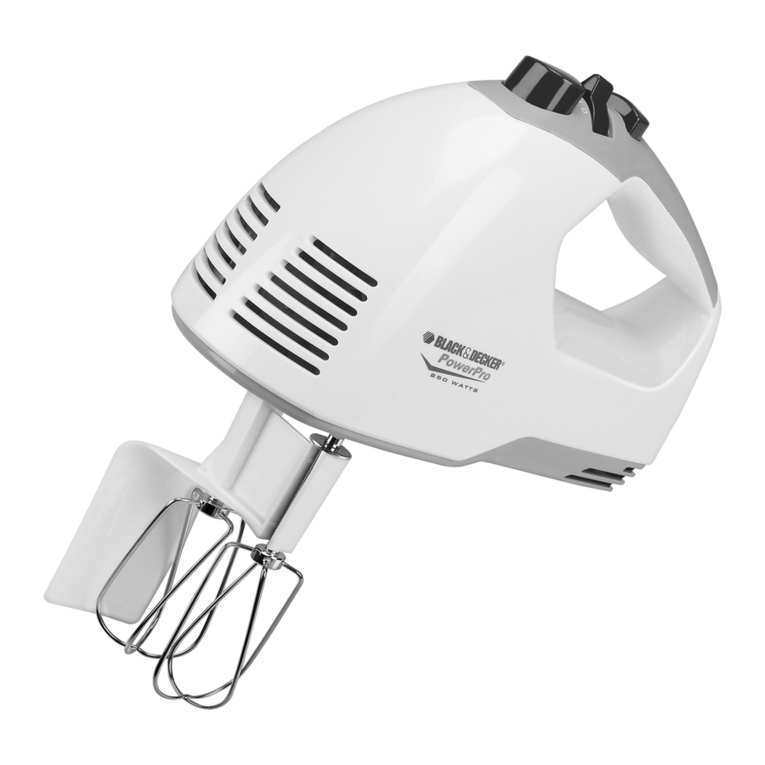
Black & Decker
Black & Decker PowerPro M200P Use and care book

Graphite
Graphite 58G084 instruction manual
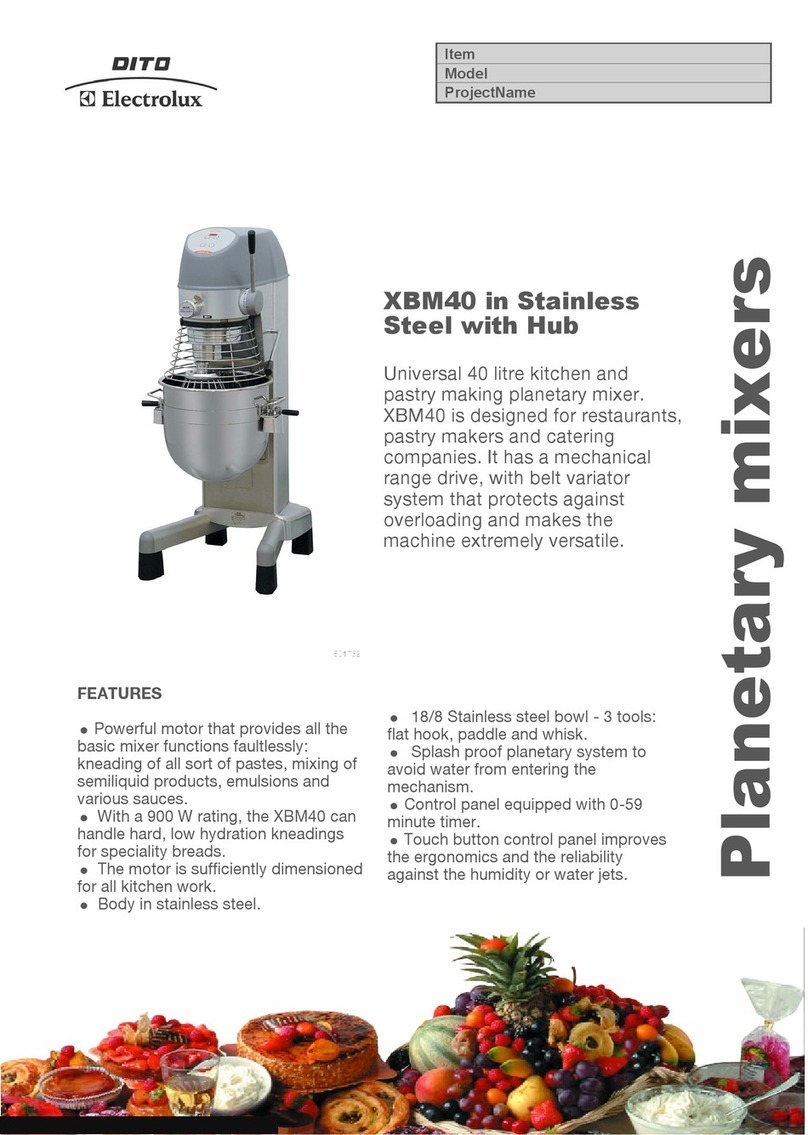
Electrolux
Electrolux Dito 601732 Brochure & specs
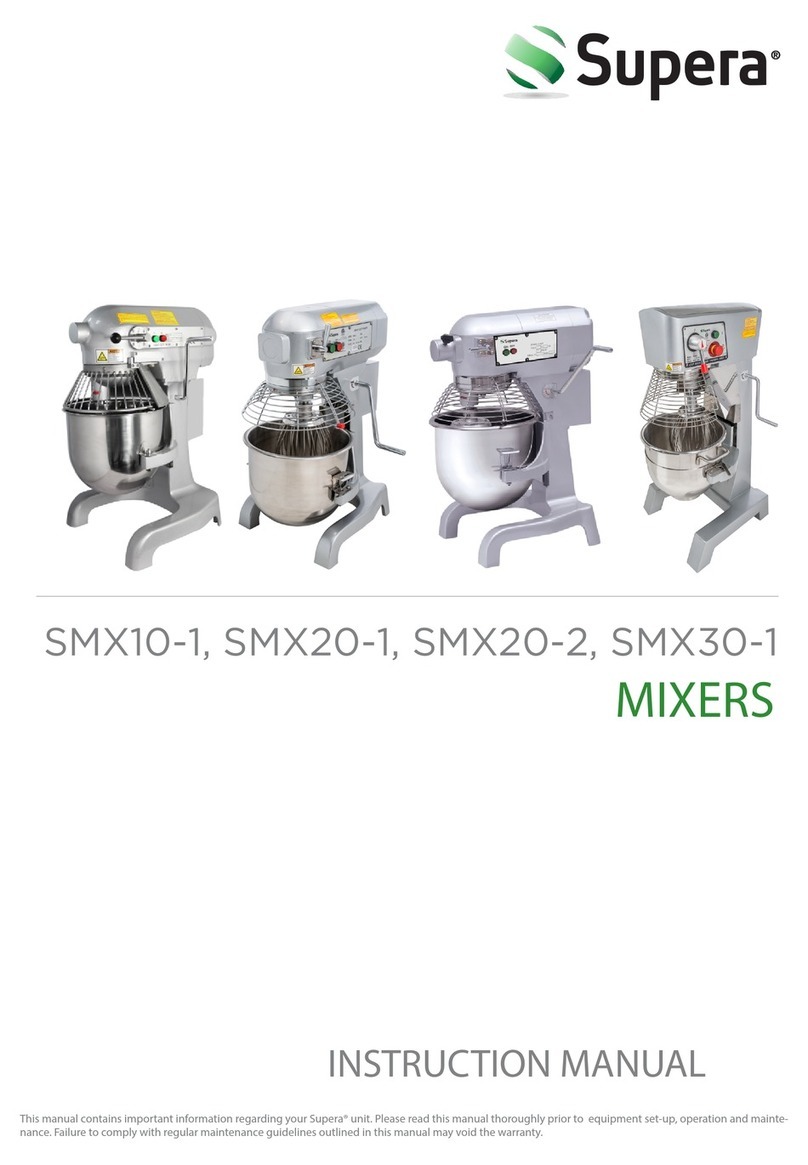
Supera
Supera SMX10-1 instruction manual

Chefman
Chefman RJ17 Series Instruction booklet

Maytag
Maytag JSM900EAAU - Jenn-Air Attrezzi Antique Copper Stand... Repair parts list
